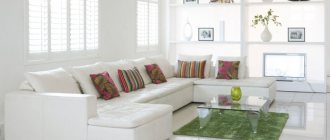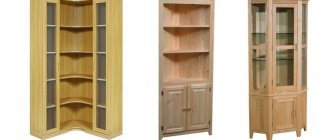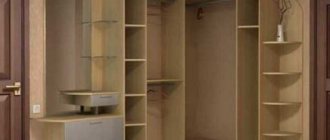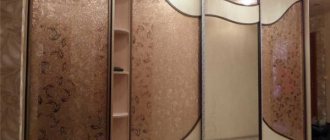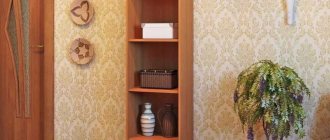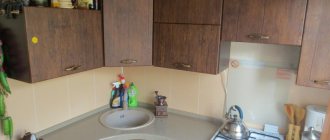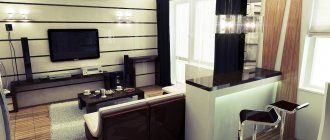Making a corner cabinet for the kitchen yourself is quite difficult, but the resulting result will meet all expectations. Creating furniture for kitchens of non-standard dimensions depends on the layout of the room. Stores do not always offer corner cupboards, which can save space in a small kitchen.
Making a corner cabinet for the kitchen yourself is quite difficult, but the result will meet all expectations
Design advantages
The positive aspects that distinguish a corner wall cabinet for the kitchen include:
- increasing the usable area of the room due to proper placement of furniture. Installation is carried out in places where it is difficult to install other options;
- high capacity and functionality. At first glance, it may seem that corner floor cabinets are not so large, however, inside them you can install a variety of shelves and arrange compartments for organized storage of food and utensils;
- the ability to choose optimal sizes, since floor-standing cabinets are varied in size. Almost every person is able to understand how to assemble comfortable cabinets for the kitchen, giving them the necessary parameters;
- variety of methods that can be used to decorate front panels. If desired, the kitchen floor cabinet can be decorated with glass inserts or patterns. This will make the finished product more attractive. However, Leroy Merlin kitchens already look aesthetically pleasing and do not require any additions;
- Possibility of combination with other items in the kitchen.
Where to begin?
At first glance, creating a cabinet with your own hands seems like a heavy and overwhelming burden, but it is not so. You just need to know what it is for, where to put it and what to store. The design of any cabinet, first of all, begins with a drawing of a piece of furniture.
If a person does not have special drawing skills, then you can turn to the World Wide Web. On the Internet, everyone can find a special program designed for this matter.
Before starting work, you need to pay attention to the size of the wardrobe and the size of the room where the piece of furniture will be placed.
The slightest deviation threatens to lead to irreparable consequences. During the drawing, you need to take into account all the small details - sockets, protrusions, heating pipes, window sill, parquet, etc.
When working on a project drawing, you need to pay special attention to two details:
- what kind of baseboard is installed in the room? In the case of designing a wardrobe from one wall to another, it will not be possible to move the item close to it. Then you need to either create a cabinet with bevels of the vertical ribs, or disassemble the baseboard itself;
- what density will the chipboard be? If there are no long bookshelves in the closet, then the thickness of the material will start from 16 mm.
When working on a drawing (especially for those types that are built under the ceiling of a room), we must not forget that the furniture is assembled in a lying position and only then the cabinet is lifted and placed. In this case, the diagonal of the cabinet should be a few centimeters lower, otherwise, when the cabinet is lifted, it will simply rest against the ceiling.
Following the instructions described above, now everyone will understand that developing a drawing, for example, of a sliding wardrobe with your own hands does not require any special skills.
How to make shoe racks with your own hands from scrap materials: useful tips, drawings and photo ideasDo-it-yourself sofa: photo and video instructions for the design, design and construction of upholstered furniture
Do-it-yourself bed: design, design and stages of making a bed (video + 75 photos)
Step-by-step instructions for creating a unique piece of furniture
- choice of location;
- drawing development;
- creation of a frame, its assembly;
- installation of a doorway;
- installation of auxiliary parts (shelves);
- use of paints and varnishes - varnishing, impregnation (if necessary) and final painting;
- installation of door handles.
Main features of corner models
The list of the most important differences includes:
- doors are not required. The open top cabinet is great for storing beautiful crockery sets;
- variety of forms. The design can be triangular, L-shaped, or even trapezoidal (by the way, triangular variations have become very widespread in our time). Choosing the right varieties depends on the people who will be using the cabinets and their preferences;
- the lower part of the structure, located on the floor, is often used to create sinks. The sink placed on top will be convenient to use;
- it is possible to integrate large types of household appliances for their more efficient operation;
- Various methods are used to decorate the facade. The most common options are applying a pattern to wall cabinets or upholstering them with some material;
- the lower cabinet under the sink is often equipped with legs, which makes cleaning the room easier;
- The upper corner cabinet can be equipped with carousel shelves to store dishes and other accessories.
Features of using a wall corner cabinet
Wall-mounted corner cabinets for the kitchen are a convenient and functional element. They can be part of the kitchen unit or located separately from it.
Advantages
Upper corner kitchen cabinets are indispensable in small spaces where there is not enough space to store dishes, food, and kitchen accessories . They are installed in the corner of the kitchen, equipped with shelves, baskets, and retractable structures. With the help of corner fittings, the cabinet will become ergonomic - it is convenient to store items that should always be at hand. It's roomy without looking bulky. This type of cabinet makes the empty corner useful. Many housewives prefer to place a corner wall cabinet above the sink - in this case it serves as a place for drying and storing dishes.
If the kitchen is spacious, a corner kitchen wall cabinet is used not only for storage, but also for decoration. They choose models with glass or open facades; photographs, tea sets, figurines or souvenirs are placed inside - any decor that the owners like. This corner makes the kitchen more cozy.
Note! Wall cabinets fit into different interiors. It can be light and light Provence, strict and minimalist high-tech, bright and original retro style.
Flaws
In a small kitchen, it is especially important to pay attention to the size of the product. Models that are too large are not suitable for a small room - they overload the space and take up a lot of space. Therefore, it is important to imagine in advance how the cabinet will look in the interior of the room. Otherwise there are no shortcomings.
Attention! The dimensions of kitchen furniture depend not only on the area of the kitchen, but also on the height of the owner. The ideal closet is one that you can easily reach.
Corner kitchen cabinet dimensions
The dimensions of kitchen furniture can vary widely. If they are included in the kitchen set, then they have optimal sizes for combining with other components of the set. If the cabinet is selected separately or designed independently, then it must match the other elements.
For a person who is going to create a corner kitchen cabinet with his own hands, it is very important to determine the dimensions of the future product. They are poured depending on whether the new piece of furniture will be located on the floor or on the wall.
The corner-type hanging cabinet has standard dimensions. The width is 15-80 cm, and this parameter must correspond to the shape of the cabinet and its width. The standard depth is 35 cm, however, the calculation must take into account the depth of the drawers that will be located below. It is recommended to install the finished product at a distance of 50 cm from the cabinets located below. These are the standard dimensions of any wall cabinet. Those people who are interested in how to calculate the corner option without making a mistake need to know this.
If we are talking about creating floor furniture, then it will have other standard sizes. They need to be taken into account when planning to make a kitchen drawing. For a compact room, a cabinet with a depth of 50 cm, no more, is better suited. The typical height is 85 cm (however, this can be varied in individual cases). The width can be 15-80 cm, with the optimal figure being 60 cm.
As a rule, the lower element is installed after the installation of the upper one has been completely completed. The owner has the right to choose furniture with or without legs.
Corner cabinet for sink
A cabinet under the sink is a very common option. Its dimensions can vary widely, as they depend on the washing parameters. You also need to take into account the method by which the structure will be secured. For such cabinets, standard sizes are calculated individually. The width can be more than 60 cm, and the depth can reach 80 cm (the downside is that such an interior element will be very difficult to use). As a rule, for large products a pair of facades is chosen. However, if necessary, assemble models with one door.
Assembling the cabinet
Now directly about the assembly process itself:
- Make blind holes and insert dowels into them to pre-fix the components of the cabinet. This way you can level the frame and increase the strength of the future product. The chops are pre-coated with glue.
- Once you insert the dowel into one piece, insert its end into the hole of the other and press the two pieces of the cabinet tightly together.
- Before completely installing the future product, check all its parts for evenness.
- Now the confirmations will be screwed into the dowels. This is done using a hex key.
- If your design included legs, it’s time to mount them to the main structure and adjust the height.
- Make holes in the sides of the future cabinet and insert cross-shaped fastenings for the doors into them using two self-tapping screws.
- On the side walls, build fastenings for the rails along which the drawers will slide out, and fix the rails themselves.
- Once the frame is created, attach a fiberboard sheet to its back wall.
- In the case of a wall cabinet, you need to attach fittings to it, with which it will be attached to the wall. Adjustable hangers will do this role perfectly.
The process of assembling a corner kitchen cabinet with your own hands
Taking measurements and drawings
The assembly of a corner cabinet cannot begin without creating a diagram. In turn, to carry out drawing work, you need to take measurements, and then create a kitchen diagram so as not to make a mistake. When performing this work, you need to take into account some nuances:
- The thickness of the walls should be chosen taking into account what objects will be placed on them. It is important to show on the diagram whether the finished structure will accommodate household appliances or not. The thickness of typical shelves is 18 mm. If you plan to store something heavy on them, it is better to choose blanks with a thickness of 21 mm or more;
- the depth of the finished products should not be more than 40 cm;
- You should not place the hanging cabinet too low if there is a stove directly underneath it, as the material will deteriorate under the influence of elevated temperatures.
According to the standards, the size of a corner cabinet is 60x60 cm, while the width of the front panel is 42 cm and the depth is 30 cm. A corner kitchen is an excellent option for small apartments where it is difficult to implement another arrangement option. Look at the photos presented on our website to find the perfect option.
1
2
3
How to use a corner cabinet
If the cabinet is located in the corner of the work area, it is used for practical purposes - for storing kitchen utensils . The element is hung separately or placed in a special niche. An interesting option is when the closet serves as a pantry - winter preparations, jars, dried vegetables and fruits are stored in it. Also, some housewives use it as a buffet - for festive and everyday tableware, bakery and pasta products, bright vases and wicker baskets.
The cabinet, located separately from the kitchen unit, looks beautiful. If it is decorated in a different color and design, it will look original and serve as a stylish accent. In addition to dishes, it stores kitchen textiles, cookbooks, small household appliances - a coffee grinder, mixer, blender. If the owner of the house collects soft toys, plates, bronze figurines, they are also placed there.
How to make a corner cabinet for the kitchen?
- Choose the right material and purchase it in the right quantity. Calculating the purchase volume is very simple if you follow the previously drawn up diagram.
- Prepare the tools necessary for the job. Their list includes: fasteners, hangers, sealing compound, furniture screed, drill, sandpaper, fittings and some other devices. It all depends on what model you plan to create.
- Prepare the basic details for the future cabinet. It is most convenient to cut them from solid slabs. Be extremely careful when performing this work and use power tools to achieve the best results. Alternatively, you can contact a specialized company that will make blanks at a professional level.
- Make through holes to insert dowels into them and fasten the individual elements that make up the furniture. Lubricate the chopsticks with adhesive to increase the reliability of the structure.
- Check the evenness of individual parts of the structure using a level.
- Screw the confirmations into the dowels using a hex wrench for this purpose.
- Install the legs and adjust the height. If the design does not require legs, this step can be skipped.
- Make holes in the side elements and place cross-shaped fastenings for the doors in them.
- On the walls located on the sides, attach elements for rails, due to which the boxes will roll out. Secure the rails.
- Attach the back wall.
- Secure the fittings.
Corner cabinet diagram
Corner cabinet drawing
The presented instructions will help every person understand how to make a corner cabinet for the kitchen with their own hands; the various diagrams and drawings presented here will simplify the solution of this problem. If you complete all the work correctly, you will enjoy the finished cabinet installed in the corner for a long time.
How to do it yourself
It is possible to prepare an original furniture design for non-standard room sizes or non-standard layouts. In this case, you can make kitchen cabinets yourself. The production of a corner model must begin with drawing up a diagram that takes into account all dimensions. Tools and material are also being prepared.
Cutting cabinet elements is a labor-intensive task, so you can cut them to order in a store or in a workshop. Before assembling the parts, it is necessary to adjust the elements to each other. Then follows the installation, installation of the frame, its covering. The body can be painted, lined with mirrors and tiles.
Measurements and drawing
When making furniture with your own hands, first determine the shape of the corner kitchen cabinet and develop drawings. You will need an area plan for the kitchen corner cabinet with the location of the sink, pipes, stove, and sockets. This will help to accurately construct the model. The parameters are determined by the purpose of the structure, which can be a work area, the base of a sink, or a place for dishes.
It is necessary to calculate the overall dimensions of the corner cabinet, then each element. With a wall-mounted structure, you need to take into account how wide the bottom module is in order to fit the structure into the corner of the kitchen corner set. Then the internal filling of the cabinet is determined, which is assembled, as a rule, from drawers, a carousel or simple shelves. The distance between the boxes is measured and a design drawing is drawn up.
Materials and tools
After determining the location of the corner cabinet and its dimensions, proceed to the selection of materials. There are requirements for the base of the upper and lower corner modules in the kitchen. The surface must be resistant to constant humidity, exposure to hot steam, and the material must be easy to clean from dirt. These requirements are met by laminated moisture-resistant chipboard, lined with artificial veneer with sheet thickness up to 18 mm.
In the manufacture of cabinets for dishes, chipboards covered with a layer of veneer are used. MDF panels have a composition that is more resistant to mechanical damage and moisture. Sheets can be matte, glossy, laminated or painted.
For corner structures, a multiplex is suitable. This material bends, is moisture resistant, is made from veneer, is coated with polyurethane varnish, and is resistant to damage. Radius corner facades can be made from multiplex.
Kitchen cabinets are also made from solid wood. The material requires impregnation and the application of protective coatings. Wood does not require additional finishing due to the natural surface pattern. Natural material has a high price.
For installation work you will need tools: a hammer drill, a drill, a tape measure, a hammer, a construction level, as well as a hacksaw and a jigsaw. When constructing a cabinet, you need PVC edges for the ends, furniture ties, hangers, self-tapping screws, sealant, sandpaper, and a drill with attachments for working with wood. You will also need a hex key, which is used to install closing mechanisms and hinges for corner doors.
Assembly
Work on assembling parts begins with the main cabinet. Experts recommend performing a rough assembly using dowels, which will allow you to determine the accuracy of the fit. Then the parts are fastened with European screws. At the periphery of the structure, it is necessary to install cross-shaped fastenings for doors using self-tapping screws. The drawer rails are mounted on the side walls.
After assembling the frame, chipboard is nailed to the back side. For a wall-mounted model, it is necessary to fix fasteners to the wall. The next stage is assembling the boxes. The walls of the structures are tightened with screws. Fragments of chipboard are mounted into the bottom of the structures under the boxes. The facades are fixed with ties, and guide elements for the drawers are installed.
At this stage, the structure is installed in the corner of the kitchen. If there will be a sink in the cabinet, it is important to make a hole for it. Then the structure is treated with sealant, fastened with self-tapping screws, and doors are hung on the cabinet.
Accessories
When assembling the internal device, you need to attach the fittings to the furniture structure. For hinged doors, a lifting mechanism with a lock is required; for hinged doors, hinges are required. Hanging cabinets are attached with special corners to the wall. A cabinet with drawers requires roller guides. During installation, dowels, pins, shelf holders, and handles are needed.
Corner fittings include pneumatic mechanisms for ease of use. Wide drawers are equipped with shock absorbers that ensure smooth sliding of elements. Dividers will help with functional filling of cabinets. They can be installed across and along the space, and the configuration can be changed.
Retractable and hanging shelves and roll-out baskets help to use furniture rationally. To increase the capacity of floor cabinets, carousel shelves are required. Many kitchen sets include special storage systems (racks, stands, holders) that are convenient to use.
